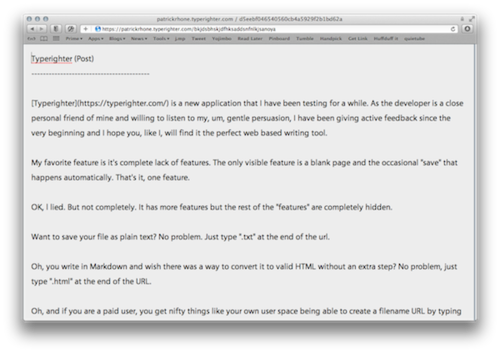
Typerighter is a new application that I have been testing for a while. As the developer is a close personal friend of mine and willing to listen to my, um, gentle persuasion, I have been giving active feedback since the very beginning and I hope you, like I, will find it the perfect web based writing tool.
My favorite feature is it’s complete lack of features. The only visible feature is a blank page and the occasional “save” that happens automatically. That’s it, one feature.
OK, l lied. But not completely. It has more features but the rest of the “features” are completely hidden.
Want to save your file as plain text? No problem. Just type “.txt” at the end of the url.
Oh, you write in Markdown and wish there was a way to convert it to valid HTML without an extra step? No problem, just type “.html” at the end of the URL.
Oh, and if you are a paid user, you get nifty things like your own user space and being able to create a filename URL by typing http://username.typerighter.com/filename and you will always be able to access your document directly at that address.
So yes, it has a few features but none of them, ever, get between you and that blank page. The way a writing app should be.
And, it works in the browser so, you know, everywhere is disco. iPad? Disco. iPhone? Hustle! Heck, throw it on your Chromebook.
I’m using it to write this letter. I drafted an essay of my book using it (on my iPad, naturally). It’s really neat. I keep it open in a browser window with a page I have set as my scratchpad. I can type a quick note in there if I’m working in Safari and not break my stride too much.
To get the extra goodness a personal Typerighter domain provides, and to support independent development, I recommend you pay the current $5.00+ cost. Because, you see, that cost increases by one cent for each person who signs up. So getting in now gets you the best price. But, you don’t have to pay to use it. Just use the “Try it out” link at the bottom of the sign up page and use it for as long as you wish.
Seriously, I hope you love this thing as much as I do. Just head on over to https://typerighter.com/ and play with it for a bit. Like I said, my good friend Garrick van Buren is the developer and he would love your feedback. Make any feature request you want as long as it can be completely invisible ;-).

